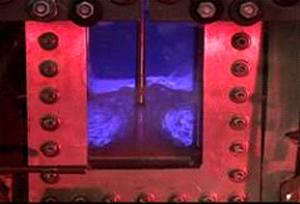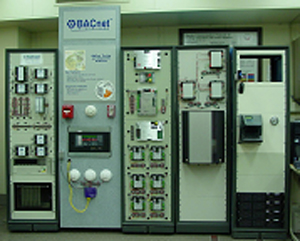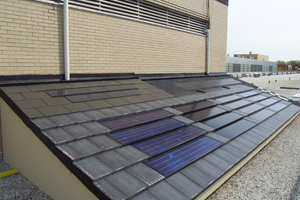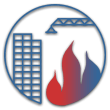|
|
|
|
|
|
|
|
|
|
|
|
 |
 |
 |
 |
|||||||
|
|
||||||||||
 |
 |
 |
 |
 |
 |
 |
 |
|||
Building Environment Division
The Building Environment Division develops measurement science, predictive models, and performance metrics to improve the energy efficiency of building components and systems, reduce building related CO2 emissions, enhance the quality of the indoor environment, and improve the building design and construction process through the integration of information, communications, sensing, and automation technologies. Focused research programs include:
- Measurement techniques and models to assess building envelope thermal and air leakage performance
- Models to quantify the generation, transport, and fate of indoor air pollutants
- Communication protocols and test beds for building sensors, controls, and energy management systems
- Development of test methods needed to assess the energy performance of building components and systems
- Measurement science and predictive performance models to explore emerging building energy related technologies and reduce measurement uncertainty
- Integration of information, communications, and automation technologies to advance the competitiveness of the U.S. building industry
Through extensive publications and active participation in consensus organizations such as the American Society of Heating, Refrigerating, and Air-Conditioning Engineers, the American Society of Mechanical Engineers, the American Society for Testing and Materials, and the Fully Integrated and Automated Technology Consortium, research results from the Division are disseminated to the private sector in a timely manner and provide the basis for many consensus standards used throughout the building industry.
A. Hunter Fanney, Chief
(301) 975-5864
hunter.fanney@nist.govResearch Programs
The Division’s research is carried out in three programs that benefit from collaborations with other NIST Divisions, industry, and other government agencies. The programs are:
Cybernetic Buildings Systems - To develop, test, integrate, and demonstrate open, intelligent building automation and control systems for energy conservation, life cycle cost savings, improved occupant productivity, safety and satisfaction, and support U.S market leadership in developing and using the technology.
CONSIAT – To develop measurement science, methods, protocols, and standards to improve construction productivity with the integration of information and automation technologies. This work is planned and conducted in close cooperation with the U.S. building industry, suppliers of advanced technologies, standards development organizations and the international research community.
Healthy and Sustainable Buildings – To provide the measurement science, performance metrics, assessment tools, and fundamental data critical for the development and implementation of technology needed to reduce greenhouse gases associated with the life-cycle operation of buildings while maintaining a healthy and productive indoor environment.
Employment Opportunities
- Applications are solicited for current openings (2008) for MS and PhD engineers and scientists. View Full Advertisement (PDF) May 2008
- Applications are being solicited for current opening (2008) for MS and PhD engineers and scientists. Position Announcements within the Building Environment Division (PDF) May 2008.
- The Building Environment Division has postdoctoral positions available for PhD engineers and scientists in a dynamic and growing research environment in the following areas: Building Controls; Building Sensor Research; Computer Integrated Building Processes; Construction Integration and Automation Program; Efficient, Smart, and Reliable; HVAC&R Equipment; Fuel Cells; Photovoltaics; Thermal Performance of Thermal Insulation; Ventilation and Indoor Air Quality in Office Buildings. Interested applicants are encouraged to contact the advisor associated with each research area. (Additional information on the NIST Postdoctoral Program.)
Division Organization
HVAC&R Equipment Performance GroupThe Group expands the scientific knowledge of air-conditioning, heat pumping, and refrigeration technology. The Group’s focus is to improve the energy efficiency of HVAC&R equipment, which is the predominant end-user of energy in buildings. The research activities include innovative and fundamental heat transfer measurements of refrigerants; experimental and analytical studies of systems and components; development of advanced modeling and optimization tools; research of novel applicable technologies; and formulation of test and rating methods for refrigerators and “mixed” air conditioners and heat pumps.
Piotr A. Domanski, Leader |
 Refrigerant Pool Boiling |
|
Mechanical Systems and Controls GroupThis group improves and lowers the cost of building services by fostering the development and use of intelligent, integrated, and optimized building mechanical systems and controls. It also develops standard communication protocols for exchanging information between building management and control systems. Research topics include automated fault detection and diagnostics, automated commissioning tools, intelligent agent based control optimization, and information modeling to integrate design and operation of building systems.
Steven T. Bushby, Leader |
 The Virtual Cybernetic Building Testbed for testing building commissioning tools, fault detection and diagnostics technology, and building system response to emergency scenarios. |
|
Heat Transfer and Alternative Energy Systems GroupThe Heat Transfer and Alternative Energy Systems Group serves the on-site energy generation and energy conservation sectors by advancing measurement science, standards, and technology related to energy utilization in buildings. The group investigates measurement issues associated with solar photovoltaic systems in buildings and produces performance data for such systems. It develops measurement techniques for assessing the performance of combined heat and power systems such as fuel cell units. The group maintains the nation’s measurement standard for thermal building insulation, and supports the development and modification of test procedures for rating the energy efficiency of water heaters and heat pumps. Development of methods to encourage the use of advanced sensor technology such as wireless sensor networks in buildings, is also a focus of the group.
William Healy, Leader |
 Residential Photovoltaic Roof Test Facility used to quantify performance of photovoltaic systems and provide data to develop/validate performance models |
|
Computer-Integrated Building Processes GroupThe Computer Integrated Building Processes Group promotes advancements in the capabilities of the U.S. building industry by developing measurement science, methods, protocols and test beds related to product, building and project data standards; information, communication and automation technologies; and improved work processes over the life cycle of the built environment. It develops methods and test cases for the evaluation and deployment of protocols and standards for the exchange, access and integration of building information. It investigates advancements in semantic modeling, data model alignment, and systems integration and works with industry and the research community to apply these to improving the design, construction and operation of the built environment.
Mark E. Palmer, Leader |
||
Indoor Air Quality and Ventilation GroupThe overall goal of this group is to support the design, construction and operation of high performance sustainable buildings with good indoor environments and low levels of energy consumption. This goal is pursued through research in the following areas: the measurement and prediction of airflow and contaminant transport in commercial and residential buildings; methods to assess energy and IAQ impacts of different ventilation strategies and IAQ controls; and, technology, guidance and predictive tools for enhanced building protection against chemical/biological/radiological agents. Current projects include the energy and IAQ implications of residential mechanical ventilation, development of test methods for the performance of gas phase air cleaning equipment, indoor exposure to ultrafine particles in residential environments, standards for measuring volatile organic compound emissions from building materials, measurement and energy impacts of envelope airtightness in commercial buildings, development of airflow and IAQ models that couple detailed room predictions with multizone simulation of whole buildings, development of advanced building simulation techniques that simultaneously account for heat, air and moisture transport, and residential exposure to carbon monoxide associated with the operation of emergency generators.
Andrew K. Persily, Leader |
 Chamber for measuring volatile organic compound emissions from building materials and for testing gas phase air cleaning devices
|
Publications
- Publications prepared by Building Environment Division Staff.
|
Privacy Policy/Security Notice/Accessability | Disclaimer | FOIA NIST is an agency of the U.S. Department of Commerce |

|
Last updated: 5/21/2008
